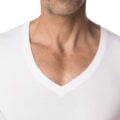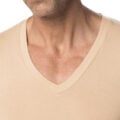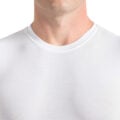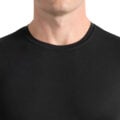
How Your Dress Should Pants Fit
How your dress pants lay says a lot about your style. Follow these simple rules to understand a proper fit.
-
By Leigh McKenzie
- Updated: February 13, 2024

Our approach to content is the same as our approach to building a great wardrobe: it's about quality, not quantity. We only recommend products we believe in and would buy for ourselves or a friend.
Here's our editorial promise:
- We only recommend products we believe in and would buy for ourselves or a friend.
- We don’t accept payment for reviews, ever. We do sometimes receive press samples.
- Every review is hands-on, meaning we actually test drive the products.
- We cover brands regardless of our relationship with them (i.e., brands that don’t offer payment for traffic).
Your trust is our #1 priority, always. Please reach out with any questions, concerns or suggestions (service@underfit.com).
The way your pants fit makes or breaks your whole look. Too big looks slouchy, too tight looks awkward, and that perfect fit, while always flattering, can be a headache to attain.
This article will take you through everything you need to know to achieve that perfect fit, including how dress pants should look and feel, choosing a fit style, and factoring in your body type.
What Does A Proper Fit Look Like?
Waistline, Seat, Rise and Crotch
The fit of your waistline, seat, rise, and crotch is integral to the overall fit and your comfort You don’t want a saggy seat, and you should try and avoid a fit that is too tight as it may limit your movement, and you run the risk of bursting through your pants if you bend over.
- Waistline – the waist of your dress pants should sit above the hip bone comfortably, not so tight it pinches, and not so loose they need a belt to stay up.
- Seat – the seat of your dress pants, from your waist to your thighs, should drape smoothly, with no pulling or sagging.
- Rise – getting the right measurements here will stop you from having a low, sagging crotch if it’s too long, or a perpetual wedgie if it’s too short. A mid to high-rise is flattering on everyone, though you might want to try a few variations to see what looks and feels best on you.
- Crotch – The crotch, where the inner thigh and rise seams meet, should be smooth against the crotch, not sagging so much it bunches, and not so tight it pulls.
Thighs
The best way to tell whether your pants fit correctly around the thighs is by checking how much material you can pinch on either side.
The optimal fabric amount you should be able to pinch is between half an inch to a full inch. If the pants are too loose, you will be able to pinch more. If they are too tight, significantly less.
Pant Leg Shape And Length
When searching for the perfect pair of trousers, you might find yourself getting caught up in current trends. Try your best to avoid trends, and this can leave you with trousers that are out of style relatively quickly. Finding a classic style, however, can help to ensure you get longevity from your dress pants.
Tapering vs. Straight Leg
Tapered pants will narrow as it gets closer to the ankle, whereas straight-leg pants have consistent widths all the way down.
Your pant style should typically be dictated by your body type. Tapered trousers help to elongate the leg and form in general, so this can be a better choice for smaller men.
Skinnier trousers can make the top half seem bigger and blockier, so heavier men might benefit from a straight leg which helps to balance the proportions.
Inseam And Outseam
- Inseam – your inseam is the measurement from the crotch to the bottom of your hem. This measurement directly corresponds to the length of your leg, and a correct measurement will prevent your pants from being too long or too short.
- Outseam – The outseam measures from the waistband to the bottom of your hem. Getting this measurement right is essential for a great fit through your waist and hips, preventing your pants from riding up if they’re too loose, or looking long and baggy if they’re too tight.
Pant Break
The break of your dress pants is the crease or fold of your pant fabric created when standing as your pant leg meets the top of your shoe. Depending on your desired silhouette, you might want to opt for a different pant length or shape to achieve your desired break.
The following break types are all acceptable choices:
- No Break – no break pants are relatively trendy options right now. To achieve this look, the bottom hem of your suit trousers stops above the ankle and doesn’t touch the tops of your shoes. It is important to remember that your socks will be visible, so try not to throw on anything too wild.
- Slight Break – with a slight break or quarter break, the pant legs sit just above the shoe, making minimal contact. This break is suitable for slimmer dress pants and is a good compromise between traditional and modern styles.
- Half Break – a half break is sometimes known as a medium or partial break. It is seen as a more traditional, conservative look and allows the pants to sit past the top of your shoes by between half and three-quarters of an inch. This style works well with straight or slim-leg pants and will work for men of all builds.
- Full Break – full break pants are the most conservative option – the pant length goes beyond the top of your dress shoes by two inches or more. This option does not suit tapered pants and is more suitable for straight-leg pants.
Read More: Slacks vs. Dress Pants
Beyond The Measuring Tape: Other Ways To Find That Perfect Dress Pant Fit
Consider Your Body Type
It’s all about balance. Shorter men, for example, should go for a no break or slight break in their pants to appear taller, while taller men should go for half or full breaks to offset their height.
The same goes for body weight distribution. As a general rule of thumb, more tapered styles with less fabric, like skinny and slim-fit, look better on slimmer guys. Modern, classic and regular-fit styles, however, work best on average and bigger guys.
While these are helpful guidelines to start with, they’re not rigid rules. Feel free to experiment with different suit styles until you land on one that makes you look and feel your best.
Go To A Tailor
Buying dress pants off the peg offers convenience, but using a tailor ensures your measurements are accurate and your dress pants fit perfectly.
You can also trust a tailor to know what will look best on you, so if you’re having trouble choosing a pant shape or break style, ask their expert advice.
Wear A Fitted Undershirt
Skip the baggy undershirt – excess fabric can make you look sloppy, disheveled, and corrupt your nicely tailored silhouette, making you look heavier than you actually are. Instead, always opt for something more fitted, so you preserve your shape and maintain a clean, polished look.
Take a step further and go with a premium slim fit undershirt that checks all the important boxes. UnderFit makes undershirts that hide neatly beneath your outer layers, wick moisture and sweat, streamline your shape and protect you from odor.
Read More: When To Wear an Undershirt
FAQs
Are Dress Pants Supposed To Be Tight?
Dress trousers can be slim fitting but should not be tight. You should never feel uncomfortable, and there should be about a finger’s worth of space between your waist and the waistband. This will allow you to sit comfortably and keep your shirt tucked in easily.
Should Dress Pants Be A Little Loose Around The Waist?
The space around the natural waist of your dress pants should be around one finger wide. You should be able to wear trousers comfortably without a belt, and there shouldn’t be any pinching.
Where Should Suit Pants Hit?
The break of your pants will depend on your preferred appearance and trouser style. The break can be anywhere from above the ankle on tapered, slimmer pants to beyond the top of the shoe, covering the laces.
You should never struggle with your pants getting caught under the back of your heel, and this would indicate the dress pant length is too long.
About Leigh McKenzie
Leigh is the owner of UnderFit, a premium men's undershirt brand based in Philadelphia, PA. You can follow Leigh on LinkedIn and Twitter.
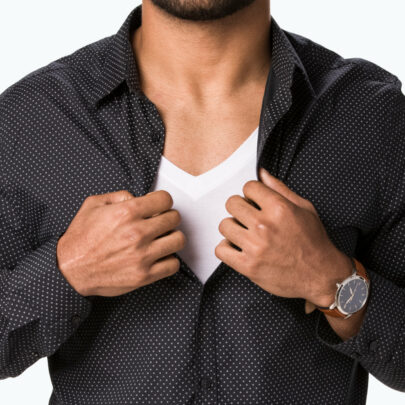
Meet Your New Favorite Undershirts
-
Anti-Pilling
-
Incredibly Soft
-
Breathable
-
Moisture-Wicking
-
4-Way Stretch
-
Anti-Odor
Try UnderFit for 100 days. Experience mind-blowing softness or get your money back.
Welcome Back
Don’t have an account? Sign up
New Here?
Already have an account? Log in
Forgot your password?
We will send you an email to reset your password.
